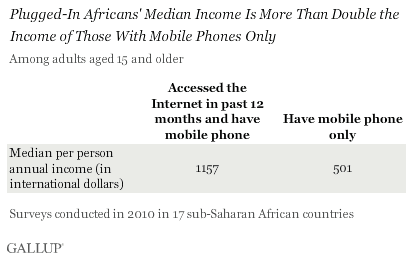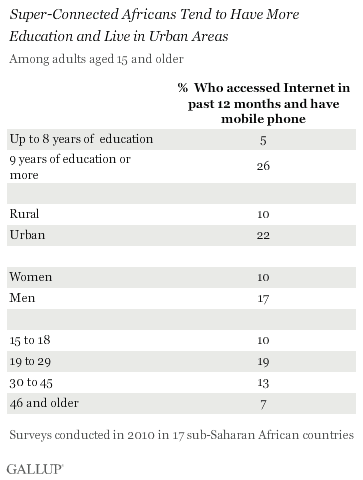This is the second of two articles that examine access to information and communications technology in sub-Saharan Africa.
WASHINGTON, D.C. -- Fourteen percent of residents polled in 17 sub-Saharan African countries reported both owning a mobile phone and accessing the Internet in 2010. These "super-connected" Africans represent about 36 million adults in a region beset with information and communications technology (ICT) challenges. As such, the findings provide important information about the size and demographics of the ICT market in those countries.

Connectivity ranges from some to virtually none across the region. More than one in five adults in Botswana and Uganda have mobile phones and Internet access, while only 1% in Niger say the same. This ICT gap is largely based on economics. Several of the countries that are the most connected are middle-income countries, with low-income Kenya, Uganda, and Zimbabwe being notable exceptions. Most low-income countries surveyed have lower-than-average connectivity.
More Money Equals More ICT Access
Income is an indicator of mobile phone ownership in sub-Saharan Africa, but income is even more important when considering the combination of phone ownership and Internet access. Median incomes among those who have access to both are twice as high as they are among those who just have a mobile phone.

Education and Urban Location Related to Connectivity
Beyond income, education also determines connectivity. Overall, those with nine years or more of formal education are five times more likely than those with less education to say they have a mobile phone and have accessed the Internet in the past 12 months. However, in Uganda, education makes little difference.
Location is also important. Those living in urban areas are far more likely than those in rural communities to report having both a mobile phone and Internet access. At the same time, location makes less of a difference in Ghana, South Africa, Uganda, and Zimbabwe.
Overall, there are no gender differences within countries, except in Nigeria and Senegal, where men are more likely than women to report having a mobile phone and Internet access. In addition, age is not a factor within countries, but in Cameroon those aged 19 to 29 years are the most likely of all age groups to be super-connected.

Implications
While the data do not address the speed and reliability of the mobile phone and Internet services super-connected individuals have in the region, the results provide an important measure of the current size of the ICT market in 17 African countries. National governments, in partnership with telecommunications providers and other stakeholders, must first address challenges such as computer literacy, hardware and software costs, as well as technical issues to bring affordable broadband to more people in the region.
Just as mobile phone technology has enabled many Africans to jump over the dearth of landlines, developments in ICT offer residents the opportunity to leapfrog current inadequacies in education, health, and business. New applications in information technology, for example, can create virtual libraries and overcome the shortage of physical libraries. Further, information and communications technology holds the promise to connect sub-Saharan Africans not only to others around the world, but also to each other.
For complete data sets or custom research from the more than 150 countries Gallup continually surveys, please contact SocialandEconomicAnalysis@gallup.com or call 202.715.3030.
Survey Methods
Results are based on face-to-face interviews with 1,000 adults, aged 15 and older, conducted in 2010 in Botswana, Burkina Faso, Cameroon, Central African Republic, Chad, Ghana, Kenya, Liberia, Mali, Niger, Nigeria, Senegal, Sierra Leone, South Africa, Tanzania, Uganda, and Zimbabwe. For results based on the total sample of national adults, one can say with 95% confidence that the maximum margin of sampling error ranges from ±3.4 percentage points to ±4.1 percentage points. The margin of error reflects the influence of data weighting. In addition to sampling error, question wording and practical difficulties in conducting surveys can introduce error or bias into the findings of public opinion polls.
The following questions were used to determine the percentage of the super-connected population in each country:
Do you yourself have a cell/mobile phone?
Have you yourself accessed / used the Internet in the past 12 months?
For more complete methodology and specific survey dates, please review Gallup's Country Data Set details.
